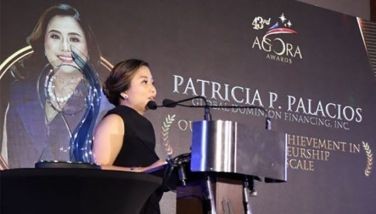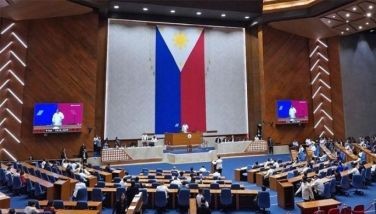SL Agritech: Sowing the seeds of prosperity
MANILA, Philippines - Exactly a week before he died of cardiac arrest in April, former Food Ministry chief Jesus Tanchanco was in a harvest festival in Talavera, Nueva Ecija. He was cheerfully advocating among the local farmers the use of hybrid rice seeds, as key to financial freedom and the country’s quest for rice sufficiency.
The country’s first National Food Authority chairman was specifically vouching for SL-8H, a kind of hybrid rice seed developed and commercially propagated nationwide by Filipino-Chinese businessman Henry Lim Bon Liong.
Henry Lim, Tanchanco said, is a Filipino who loves his country and intends to stay rooted in the Philippines for the rest of his life. The two gentlemen shared the same vision of a food-sufficient Philippines, backed by farmers who are not poor but living comfortably through dignified hard work.
At the very least, Tanchanco had a glimpse of that dream. After 40 years since the Masagana 99 program under his watch, the Philippines last year started exporting rice again.
On May 6, 2013, 35 metric tons of the staple was shipped from Manila to Dubai. The shipment consisted of 15 metric tons of organic black rice produced by farmers of Don Bosco Foundation for Sustainable Development Inc. in North Cotabato and 20 metric tons of aromatic long grain rice produced by Lim’s SL Agritech Corp.
SL Agritech now continuously exports its Doña Maria premium rice brand to Dubai and other parts of the Middle East. France’s Carrefour, Europe’s biggest supermarket chain and world’s second biggest retailer next to Wal Mart, offered to distribute the Philippine-grown fancy rice.
Packed in two-kilogram, five-kilogram, and 10-kilogram bags, SL Agritech’s Dona Maria rice exports are mainly meant to cater to rice-loving Filipinos in the Middle East, where they usually eat rice imported from Thailand.
“Half of the Dubai population are Filipinos,†relates Donna T. Lim, the family firm’s assistant vice president for supply chain. “We did a little twist on our packaging to make them support Philippine-grown rice, and therefore help Filipino farmers.â€
Doña Maria rice, named after Henry Lim’s late visionary mother, is mainly produced in a farm in Davao Oriental through contract-growing. SL Agritech provides the seed to the farmers for free, and then buys all the harvested crops at higher-than-market prices.
The Lim family notes that if their company’s export volume keeps its pace, it would be more than enough to hit the Department of Agriculture’s export target of 200 metric tons for 2014.
Last October, Doña Maria rice was also placed on the shelves of supermarkets in Los Angeles, California in the US, with international retailer Triple A as distributor.
Alongside these rice exports, SL Agritech is also selling hybrid seeds to other countries, primarily, Bangladesh, Indonesia, and Vietnam.
“It’s so ironic, we sell seeds to Vietnam but buy rice from them,†laments Henry Lim.
Just recently, the National Food Authority awarded to two Vietnamese companies the supply of 800,000 metric tons of rice to be imported in batches from May to August this year.
Agriculture officials explain that the rice imports, despite the country’s renewed ability to export the staple mainly through private sector initiatives, are only for the government’s buffer stock for the lean months of July to September, and as contingency stock for calamities.
Over a year ago, the Asian Development Bank reportedly cautioned the Philippine government from aggressively pursuing its no-importation and rice sufficiency goals. The ADB said this might muddy the country’s trade commitments with rice exporting nations.
Of late, according to the Vietnam Food Association, Vietnam’s rice export industry has been feeling the pinch of lower demand from major customers like the Philippines and Indonesia, which are all working for rice self-sufficiency.
Meanwhile, SL Agritech is looking at Indonesia, Bangladesh, and Vietnam for additional cultivation areas for development of more hybrid rice, even just for its SL-8H variety. The company will provide the parental seeds and technical assistance.
“Hybrid rice is not GMO (genetically modified organism),†stresses Lim. “Like with Filipino-Chinese people, hybrid rice is just the product of a cross pollination process between two different superior rice varieties.â€
The conventional inbred rice, he explains, is the product of just one rice variety, as rice is a self-pollinating plant.
Lim invested P100 million to put up SL Agritech in 1998 and study the hybrid rice technology. He sought the guidance of Prof. Yuan Long Pin of China, who has been credited globally for turning his country into the world’s top rice producer because of his hybrid rice technology research.
In turn, Lim introduced hybrid rice farming in a commercial scale in the Philippines in 2001, when he came up with SL-8H. Unlike the hybrid rice seeds in China, the SL-8H is suited to the Philippines’ tropical climate. SL Agritech has since come up with more superior hybrid rice varieties.
Farmers who use SL Agritech’s hybrid rice varieties profess that their crop yields have gone up by at least 16 percent compared to when they used inbred rice seeds. Some even claim their earnings have doubled, as their crops, specifically from SL-8H, have commanded higher prices in the market due to better quality, in terms of size, texture, and taste.
They say the slight difference between the cost of hybrid and inbred rice seeds is more than compensated by the income they generate from using hybrid rice seeds. They add that sowing hybrid rice seeds has elevated their living standards and enabled them to see their children through college.
Lim tells the farmers in Tagalog: “It’s your choice. If you want to keep riding a tricycle, you keep using the traditional inbred rice. If you want to drive your own Pajero, then you shift to hybrid rice.â€
The Bureau of Agricultural Statistics also noted that hybrid rice producers are more disciplined and confident of their agricultural skills compared to their peers.
While some farmers groups in the country rant about poverty, inequality, land reform, and demand for government support, hybrid rice producers are happy and proud of their work.
“Farming is in the heart,†says 74-year-old farmer Severino Payumo from Nueva Ecija in Tagalog. Payumo posted the country’s highest record of harvesting over 345 cavans (17.28 metric tons) of paddy in a single hectare of land in 2012. That’s more than double the average yield per hectare from the conventional inbred rice seeds.
The Philippines has about 150,000-180,000 hectares of land planted to hybrid rice, only a small fraction of the country’s total rice lands.
SL Agritech accounts for about 80 percent of the local hybrid rice seed market. The rest are from several other private companies and government entities, according to the Philippine Rice Research Institute.
“We still have a long way to go,†says Lim, adding that more government support in terms of information dissemination and technology demonstrations in various parts of the country is needed to further spread the benefit of hybrid rice nationwide.
But he frowns at the idea of government rice subsidies, saying it is a double-bladed proposition. He says infrastructure support and post-harvest facilities are much more necessary and effective.
- Latest




























